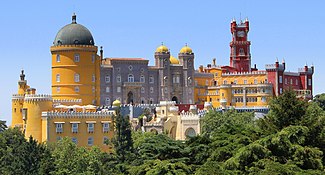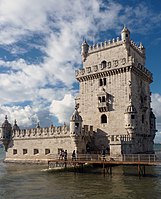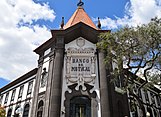
Back عمارة برتغالية Arabic Arquitectura de Portugal Catalan Arkitekturo de Portugalio Esperanto Arquitectura de Portugal Spanish Architecture du Portugal French Arsitektur Portugal ID Arquitetura de Portugal Portuguese Архитектура Португалии Russian Portugalská architektúra Slovak Portugalska arhitektura Slovenian
This article needs additional citations for verification. (November 2022) |
|
Clockwise: Pena Palace in Sintra, Praça da Liberdade in Porto, Monserrate Palace in Sintra, MAAT Museum of Art, Architecture, and Technology in Lisbon, Banco de Portugal in Funchal, Belém Tower in Lisbon. |
Portuguese architecture refers to both the architecture of Portugal's modern-day territory in Continental Portugal, the Azores and Madeira, as well as the architectural heritage/patrimony of Portuguese architects and styles throughout the world, particularly in countries formerly part of the Portuguese Empire.
Like all aspects of Portuguese culture, Portuguese architecture reflects the artistic influences of the various cultures that have either inhabited Portugal or come in contact with the Portuguese people throughout the history of Portugal, including the Gallaecians, Lusitanians, Celtiberians, Romans, Suebi, Visigoths, Moors, Goans, Macanese, Kristang people, and many more. Because of the history of the Portuguese Empire, several countries across the world are home to sizable heritages of Portuguese colonial architecture, notably Brazil and Uruguay in the Americas, Angola, Cabo Verde, São Tomé and Príncipe, Benin, Ghana, Morocco, Guinea Bissau, Zimbabwe, and Mozambique in Africa, and China, India, Indonesia, Malaysia, and Timor Leste in Asia.
Various artistic styles or movements have dominated Portuguese architecture throughout the ages, including Romanesque, Gothic, Manueline, Portuguese Renaissance, Portuguese Baroque, Rococo, Pombaline, Neo-Manueline, Soft Portuguese style, and contemporary architecture. Notable Portuguese architects of the past have included Diogo de Arruda (15–16th c.), João Antunes (17th c.), Eugénio dos Santos and Carlos Mardel (18th c.), José Luis Monteiro (19th c.), Raul Lino, Cassiano Branco and Fernando Távora (20th c.). Famous living architects include Gonçalo Byrne, Eduardo Souto de Moura (Pritzker winner), António Maria Braga, João Carrilho da Graça and Álvaro Siza Vieira (Priktzer winner).
© MMXXIII Rich X Search. We shall prevail. All rights reserved. Rich X Search





